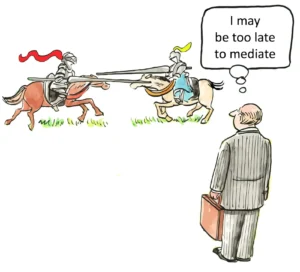Business Contract Disputes: Strategies for Legal Resolution
Business contract disputes are a common and often complex challenge in the commercial world. These disagreements can arise from various sources, including misinterpretations of contract terms, breaches of obligations, or unforeseen circumstances that impact the ability of parties to fulfill their contractual duties. The resolution of such disputes requires a strategic approach that balances legal rights, business relationships, and economic considerations. This article explores effective strategies for resolving business contract disputes, offering insights into the legal frameworks, negotiation techniques, and alternative dispute resolution methods available to businesses facing contractual conflicts.
The foundation of any contract dispute resolution strategy lies in a thorough understanding of the contract itself and the applicable law. Contract law forms the bedrock upon which business agreements are built and interpreted. When a dispute arises, the first step is to carefully review the contract’s terms, paying particular attention to clauses that govern dispute resolution, choice of law, and jurisdiction. These provisions can significantly impact the course of action available to the parties and the potential outcomes of the dispute.
One critical aspect of contract interpretation in dispute resolution is the principle of mutual assent. This fundamental concept in contract law requires that all parties to an agreement have a shared understanding of the contract’s essential terms. When disputes arise, courts often look to evidence of the parties’ intentions at the time of contract formation to determine the true meaning of contested provisions. This underscores the importance of clear and unambiguous language in contract drafting, as well as thorough documentation of negotiations and any subsequent modifications to the agreement.
The concept of consideration also plays a vital role in contract disputes. Consideration, which refers to something of value exchanged between the parties, is essential for a contract to be legally binding. In some disputes, questions may arise about whether adequate consideration was provided, particularly in cases involving contract modifications or agreements to forbear from legal action. Understanding the nuances of consideration can be crucial in determining the enforceability of a contract or specific provisions within it.
When faced with a contract dispute, businesses often turn first to negotiation as a means of resolution. Direct negotiation between the parties can be an efficient and cost-effective way to address disagreements, particularly when there is a desire to preserve the business relationship. Effective negotiation strategies in contract disputes often involve a careful balance of assertiveness in protecting one’s interests and flexibility in finding mutually acceptable solutions.
One key negotiation technique in contract disputes is the use of interest-based bargaining. This approach focuses on identifying the underlying interests of each party rather than fixating on rigid positions. By understanding the motivations and concerns driving the dispute, parties can often find creative solutions that address the core issues while potentially preserving or even strengthening the business relationship. This method can be particularly effective in disputes where the parties have an ongoing relationship that they wish to maintain despite the current conflict.
Another important consideration in contract dispute negotiations is the concept of good faith. Many jurisdictions impose an implied duty of good faith and fair dealing in contract performance and enforcement. This principle requires parties to act honestly and fairly in their dealings with one another, even when asserting their contractual rights. Demonstrating good faith efforts to resolve disputes can not only facilitate more productive negotiations but can also strengthen a party’s position if the matter ultimately proceeds to litigation.
When direct negotiations fail to resolve a contract dispute, parties often turn to alternative dispute resolution (ADR) methods. ADR encompasses a range of processes designed to resolve disputes outside of traditional court litigation. The two most common forms of ADR in business contract disputes are mediation and arbitration.
Mediation involves a neutral third party, the mediator, who facilitates discussions between the disputing parties to help them reach a mutually acceptable resolution. Unlike a judge or arbitrator, a mediator does not impose a decision on the parties but rather assists them in finding their own solution. Mediation can be particularly effective in contract disputes where there is a desire to preserve business relationships or where the parties believe that a negotiated solution is possible with the help of a skilled facilitator.
The mediation process typically begins with the mediator explaining the ground rules and process to the parties. Each side then has the opportunity to present its perspective on the dispute. The mediator may hold joint sessions with all parties present or separate caucuses with each party individually. Through these discussions, the mediator works to identify areas of agreement and disagreement, explore potential solutions, and help the parties overcome impasses.
One of the key advantages of mediation in contract disputes is its flexibility. The process can be tailored to the specific needs of the parties and the nature of the dispute. This flexibility extends to the outcome as well; mediated agreements can include creative solutions that go beyond what a court might typically order, such as restructured business relationships or performance modifications that address the underlying issues that led to the dispute.
Arbitration, on the other hand, is a more formal ADR process that resembles a simplified version of a trial. In arbitration, a neutral arbitrator or panel of arbitrators hears evidence and arguments from both sides and then issues a binding decision. Many business contracts include arbitration clauses that require parties to submit disputes to arbitration rather than litigating in court.
The arbitration process typically begins with the selection of the arbitrator(s), which may be specified in the contract or determined through a selection process agreed upon by the parties. Once selected, the arbitrator(s) will establish the rules and procedures for the arbitration, including deadlines for submitting evidence and arguments. The arbitration hearing itself is similar to a trial, with each side presenting its case through documents, witness testimony, and legal arguments.
One of the primary advantages of arbitration in contract disputes is the ability to select arbitrators with specific expertise relevant to the dispute. This can be particularly valuable in complex commercial cases where the dispute involves technical or industry-specific issues. Additionally, arbitration is generally faster and less formal than court litigation, which can lead to cost savings for the parties.
However, it is important to note that arbitration decisions are typically final and binding, with limited grounds for appeal. This finality can be both an advantage and a disadvantage, depending on the circumstances. Parties considering arbitration should carefully weigh the benefits of a potentially quicker resolution against the limited ability to challenge an unfavorable decision.
When ADR methods fail to resolve a contract dispute, or when the nature of the dispute requires formal adjudication, parties may resort to litigation. Litigation involves bringing the dispute before a court for resolution through a formal legal process. While often viewed as a last resort due to its potentially high costs and adversarial nature, litigation can provide a definitive resolution to complex contract disputes.
The litigation process typically begins with the filing of a complaint by the plaintiff, outlining the alleged breach of contract and the relief sought. The defendant then has the opportunity to respond, often by filing an answer that addresses the allegations and may include counterclaims. This initial phase is followed by discovery, during which both parties gather evidence through document requests, depositions, and other means.
One critical aspect of contract dispute litigation is the interpretation of contract terms by the court. Courts generally apply established principles of contract interpretation, such as the plain meaning rule, which states that when contract language is clear and unambiguous, it should be given its plain and ordinary meaning. However, when contract terms are ambiguous, courts may consider extrinsic evidence to determine the parties’ intentions.
Another important consideration in contract litigation is the concept of material breach. A material breach occurs when one party’s failure to perform a contractual obligation is so significant that it essentially defeats the purpose of the contract. Determining whether a breach is material can be crucial in contract disputes, as it often affects the remedies available to the non-breaching party.
The remedies available in contract dispute litigation can vary depending on the nature of the breach and the terms of the contract. Common remedies include:
- Compensatory damages: These are designed to put the non-breaching party in the position they would have been in had the contract been performed as agreed. This can include direct damages (such as the cost of obtaining substitute performance) and consequential damages (such as lost profits resulting from the breach).
- Specific performance: In some cases, particularly where monetary damages would be inadequate, a court may order the breaching party to perform their contractual obligations as agreed.
- Rescission: This remedy involves canceling the contract and returning the parties to their pre-contractual positions.
- Reformation: In cases where a mistake in the contract’s drafting led to the dispute, a court may reform or rewrite the contract to reflect the parties’ true intentions.
- Liquidated damages: If the contract includes a liquidated damages clause specifying a predetermined amount to be paid in the event of a breach, courts may enforce this provision if it is found to be a reasonable estimate of potential damages.
The choice of remedy can significantly impact the outcome of a contract dispute, and parties should carefully consider their options in light of their specific circumstances and objectives.
In recent years, there has been a growing trend towards the use of technology in contract dispute resolution. This includes the use of artificial intelligence and machine learning algorithms to analyze contract language and predict potential areas of dispute. These tools can be particularly useful in complex commercial contracts with multiple interconnected provisions.
Additionally, online dispute resolution (ODR) platforms have emerged as a cost-effective and efficient means of resolving certain types of contract disputes, particularly in e-commerce and other digital transactions. These platforms often combine elements of negotiation, mediation, and arbitration in a digital environment, allowing parties to resolve disputes without the need for in-person meetings or court appearances.
Another important trend in contract dispute resolution is the increasing focus on preventive law approaches. This involves proactively identifying and addressing potential sources of conflict before they escalate into full-blown disputes. Strategies may include regular contract audits, clear communication protocols, and the use of contract management software to track performance and compliance.
The globalization of business has also introduced new complexities to contract dispute resolution. International contract disputes often involve questions of jurisdiction, choice of law, and the enforceability of judgments across borders. The United Nations Convention on Contracts for the International Sale of Goods (CISG) provides a uniform framework for certain international sales contracts, but many cross-border disputes still require careful navigation of multiple legal systems.
In conclusion, resolving business contract disputes requires a multifaceted approach that combines legal expertise, strategic thinking, and an understanding of the various resolution mechanisms available. Whether through negotiation, ADR methods, or litigation, the key to successful dispute resolution lies in a thorough understanding of the contract, the applicable law, and the practical and relational implications of different resolution strategies. By carefully considering these factors and adapting their approach to the specific circumstances of each dispute, businesses can navigate contract conflicts more effectively, preserving valuable relationships and protecting their legal and economic interests.
- https://www.pon.harvard.edu/daily/dispute-resolution/in-contract-negotiations-agree-on-how-youll-disagree/
- https://www.globallegallawfirm.com/the-most-common-types-of-contract-disputes/
- https://www.top.legal/en/knowledge/contract-dispute-resolution-process
- https://www.giambronelaw.com/site/advice/commercial-litigation/contractual-disputes/resolving-contract-disputes-for-businesses/
- https://www.zoppi.co.uk/blog/mastering-commercial-contract-dispute-resolution-strategies-and-tips
- https://www.dwt.com/blogs/family-business-resource-center/2022/03/alternative-dispute-resolution-methods
- https://www.schwabgasparini.com/blog/methods-for-preventing-contract-disputes/
- https://kolblaw.com/5-common-causes-of-business-contract-disputes/
- https://www.pon.harvard.edu/daily/dispute-resolution/what-are-the-three-basic-types-of-dispute-resolution-what-to-know-about-mediation-arbitration-and-litigation/
- https://gowlingwlg.com/en/insights-resources/articles/2023/top-10-tips-for-managing-contractual-disputes
- https://www.communitylawfirm.com/blog/effective-strategies-avoiding-contract-disputes
- https://www.adr.org/sites/default/files/document_repository/Drafting_Dispute_Resolution_Clauses-A_Practical_Guide.pdf
- https://quizlet.com/study-guides/key-concepts-in-contract-disputes-and-resolutions-eff30d1c-5356-420e-aa5e-97c8eb5cd9b0
- https://legal.thomsonreuters.com/blog/commercial-litigation-legal-glossary/
- https://www.docjuris.com/post/contract-law-fundamental-concepts-and-principles-explained
- https://www.findlaw.com/smallbusiness/business-contracts-forms/contract-terms-checklist.html
- https://juro.com/learn/contract-terminology-legal-jargon
- https://www.volody.com/resource/contract-disputes-a-comprehensive-guide/
- https://legal.thomsonreuters.com/blog/the-principles-of-contract-law/
- https://www.business.com/articles/legal-terms/
- https://www.kppblaw.com/litigation-dispute-resolution/contract-disputes/
- https://www.lawinfo.com/resources/business-law/common-contract-terms-explained.html
- https://paperform.co/blog/contract-terminology-glossary/
- https://spzlegal.com/blog/employment/important-contract-terms-service-agreements
- https://www.gierachlawfirm.com/what-do-all-these-words-mean-contract-term-glossary-for-business-owners/
- https://www.concord.app/blog/contract-dispute-resolution/
- https://highswartz.com/legal-insights/7-essential-business-contracts/
- https://www.hartman.law/blog/2024/june/understanding-business-litigation-common-dispute/
- https://barprephero.com/legal-terms/contracts/


















